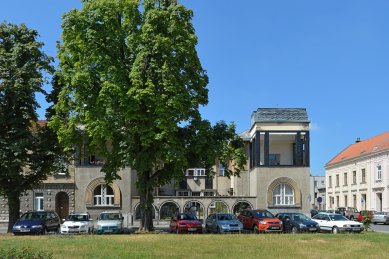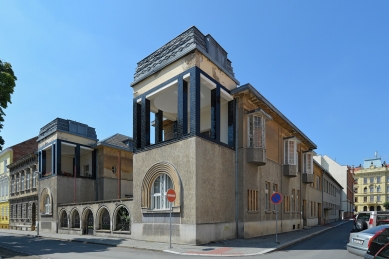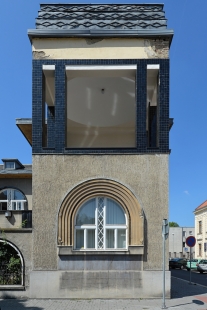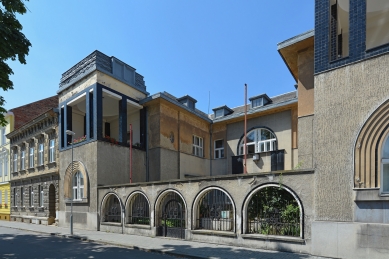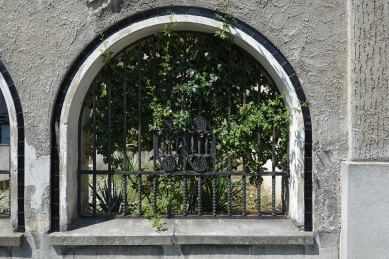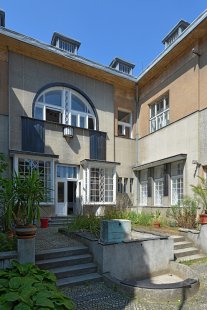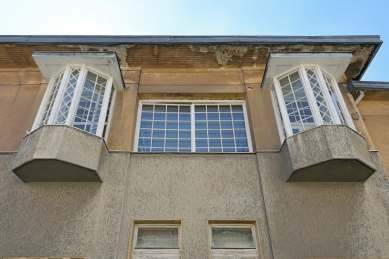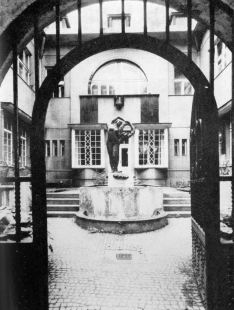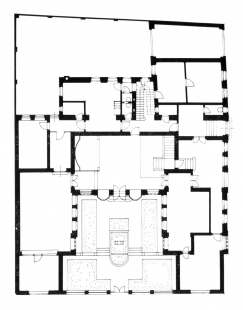
Villa of František Kovářík

Family houses J. Kovaříka on Vojáčkovo Square and F. Kovaříka on Fallen Heroes Square in Prostějov are a convincing expression of individualistic modernity. In the projects from 1910, realized in 1910-11, the author functionally and dispositionally draws from the type of English family house, whose core is the living hall. In a progressive, free manner, he arranges the rooms according to their intended purpose, creating a vital spatial organism through their interconnection, which also accommodates the needs of social representation. In the author's earlier works, the latent classical note is now emphasized by the application of the atrium idea, influencing and complementing both functions of the dwelling, private and social.
The house on Vojáčkovo Square with a deep layout and rich furnishings is integrated into the street development, whereas the house on Fallen Heroes Square utilizes its corner position generously. Its loosely grouped interior spaces are tied to the axial composition of the entrance façade with a cour d'honneur on two levels, bordered by two side wings, lightened by loggias on the floor, and enclosed to the square by a wall punctured with arches and filled with a lattice. Emil Králík embodies in a distinctive way the post-Secession architectural modernity. He definitively excluded the decorative apparatus, emphasized the axial symmetry of the solutions and forms of the exterior, utilized the natural beauty of materials, and tectonic forms, which became the bearers of architectural expression. The ingenious balance of horizontal and supporting elements, softened by prominent arch motifs, the elevated and acknowledged constructive order, all this creates a sense of harmony, calmness, and certainty in mutual interplay, invoking distant echoes of classical tradition through new means. With his rationalism and relation to construction and material as factors of architectural expression, E. Králík preceded his time and contributed to the creation of domestic conditions for the emergence and development of interwar functionalism and constructivism. The artistic principles of creation, which he reached through a complex path of self-discovery, are closely related to Adolf Loos.
The house on Vojáčkovo Square with a deep layout and rich furnishings is integrated into the street development, whereas the house on Fallen Heroes Square utilizes its corner position generously. Its loosely grouped interior spaces are tied to the axial composition of the entrance façade with a cour d'honneur on two levels, bordered by two side wings, lightened by loggias on the floor, and enclosed to the square by a wall punctured with arches and filled with a lattice. Emil Králík embodies in a distinctive way the post-Secession architectural modernity. He definitively excluded the decorative apparatus, emphasized the axial symmetry of the solutions and forms of the exterior, utilized the natural beauty of materials, and tectonic forms, which became the bearers of architectural expression. The ingenious balance of horizontal and supporting elements, softened by prominent arch motifs, the elevated and acknowledged constructive order, all this creates a sense of harmony, calmness, and certainty in mutual interplay, invoking distant echoes of classical tradition through new means. With his rationalism and relation to construction and material as factors of architectural expression, E. Králík preceded his time and contributed to the creation of domestic conditions for the emergence and development of interwar functionalism and constructivism. The artistic principles of creation, which he reached through a complex path of self-discovery, are closely related to Adolf Loos.
Crhonek, I. Emil Králík 1880-1946 architektonické dílo - edice katalogy architektura, Muzeum města Brna, 1988, s. 21-25
The English translation is powered by AI tool. Switch to Czech to view the original text source.
0 comments
add comment


